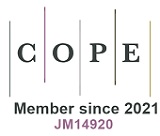Case Report on Diffuse Large B-Cell Non-Hodgkin Lymphoma with a Spontaneous Bowel Perforation
Downloads
Doi:10.28991/SciMedJ-2023-05-01-05
Full Text:PDF
Downloads
Battah, A., Abed, H., Shamoon, D., DaCosta, T., Farouji, I., & Fedida, A. (2022). A rare case of diffuse large B-cell lymphoma presenting as a malignant mass in both duodenum and ascending colon. Radiology Case Reports, 17(9), 3286–3290. doi:10.1016/j.radcr.2022.06.030.
Sapkota S., and Shaikh H. (2021). Non-Hodgkin Lymphoma. StatPearls Publishing, Florida, United States. Available online: https://www.ncbi.nlm.nih.gov/books/NBK559328/?report=classic (accessed on February 2023).
Li, B., Shi, Y., He, X., Zou, S., Zhou, S., Dong, M., Yang, J., Liu, P., & Xue, L. (2008). Primary non-Hodgkin lymphomas in the small and large intestine: clinicopathological characteristics and management of 40 patients. International Journal of Hematology, 87(4), 375–381. doi:10.1007/s12185-008-0068-5.
Ghimire P, Wu GY, Zhu L. (2011). Primary gastrointestinal lymphoma. World Journal of Gastroenterology, 17(6), 697. doi:10.3748/wjg.v17.i6.697.
Haddad, I., El Kurdi, B., El Iskandarani, M., Babar, S., & Young, M. (2019). Primary Diffuse Large B-cell Lymphoma of the Sigmoid Colon. Cureus, 11(6), 5048. doi:10.7759/cureus.5048.
Nakamura, S., Matsumoto, T., Iida, M., Yao, T., & Tsuneyoshi, M. (2003). Primary gastrointestinal lymphoma in Japan: A clinicopathologic analysis of 455 patients with special reference to its time trends. Cancer, 97(10), 2462–2473. doi:10.1002/cncr.11415.
Coté, T. R., Biggar, R. J., Rosenberg, P. S., Devesa, S. S., Percy, C., Yellin, F. J., Lemp, G., Hardy, C., Geodert, J. J., Blattner, W. A., Lemp, G.,… Parkin, W. (1997). Non-Hodgkin’s lymphoma among people with aids: Incidence, presentation and public health burden. In International Journal of Cancer, 73(5), 645–650). doi:10.1002/(SICI)1097-0215(19971127)73:5<645::AID-IJC6>3.0.CO;2-X.
Nanthakwang, N., Rattarittamrong, E., Rattanathammethee, T., Chai-Adisaksopha, C., Tantiworawit, A., Norrasethada, L., & Ya-In, C. (2019). Clinicopathological study and outcomes of primary extranodal lymphoma. Hematology Reports, 11(4), 79–83. doi:10.4081/hr.2019.8227.
Vaidya, R., Habermann, T. M., Donohue, J. H., Ristow, K. M., Maurer, M. J., Macon, W. R., Colgan, J. P., Inwards, D. J., Ansell, S. M., Porrata, L. F., Micallef, I. N., Johnston, P. B., Markovic, S. N., Thompson, C. A., Nowakowski, G. S., & Witzig Dr., T. E. (2013). Bowel perforation in intestinal lymphoma: Incidence and clinical features. Annals of Oncology, 24(9), 2439–2443. doi:10.1093/annonc/mdt188.
Wiggill, T. M., Mantina, H., Willem, P., Perner, Y., & Stevens, W. S. (2011). Changing pattern of lymphoma subgroups at a tertiary academic complex in a high-prevalence HIV setting: A South African perspective. Journal of Acquired Immune Deficiency Syndromes, 56(5), 460–466. doi:10.1097/QAI.0b013e31820bb06a.
Yang, Q. P., Zhang, W. Y., Yu, J. B., Zhao, S., Xu, H., Wang, W. Y., Bi, C. F., Zuo, Z., Wang, X. Q., Huang, J., Dai, L., & Liu, W. P. (2011). Subtype distribution of lymphomas in Southwest China: Analysis of 6,382 cases using WHO classification in a single institution. Diagnostic Pathology, 6(1). doi:10.1186/1746-1596-6-77.
Verburgh, E., & Antel, K. (2019). Approach to lymphoma diagnosis and management in South Africa. South African Medical Journal, 109(10), 715–718. doi:10.7196/SAMJ.2019.V109I10.14360.
Kako, S., Oshima, K., Sato, M., Terasako, K., Okuda, S., Nakasone, H., Yamazaki, R., Tanaka, Y., Tanihara, A., Kawamura, Y., Kiyosaki, H., Higuchi, T., Nishida, J., Konishi, F., & Kanda, Y. (2009). Clinical outcome in patients with small intestinal non-Hodgkin lymphoma. Leukemia and Lymphoma, 50(10), 1618–1624. doi:10.1080/10428190903147629.
Singh, V., Gor, D., Gupta, V., Jacob, A., Du, D., Eltoukhy, H., & Meghal, T. (2022). Epidemiology and Determinants of Survival for Primary Intestinal Non-Hodgkin Lymphoma: A Population-Based Study. World Journal of Oncology, 13(4), 159–171. doi:10.14740/WJON1504.
Aleman, B. M. P., Haas, R. L. M., & van der Maazen, R. W. M. (2010). Role of radiotherapy in the treatment of lymphomas of the gastrointestinal tract. In Best Practice and Research: Clinical Gastroenterology (Vol. 24, Issue 1, pp. 27–34). doi:10.1016/j.bpg.2009.12.002.
Lu, P. W., Fields, A. C., Yoo, J., Irani, J., Goldberg, J. E., Bleday, R., & Melnitchouk, N. (2021). Surgical Management of Small Bowel Lymphoma. Journal of Gastrointestinal Surgery, 25(3), 757–765. doi:10.1007/s11605-020-04730-3.
Maguire, L. H., Geiger, T. M., Hardiman, K. M., Regenbogen, S. E., Hopkins, M. B., Muldoon, R. L., Ford, M. M., & Hawkins, A. T. (2019). Surgical management of primary colonic lymphoma: Big data for a rare problem. Journal of Surgical Oncology, 120(3), 431–437. doi:10.1002/jso.25582.
Kim, S. J., Kang, H. J., Kim, J. S., Oh, S. Y., Choi, C. W., Lee, S. Il, Won, J. H., Kim, M. K., Kwon, J. H., Mun, Y. C., Kwak, J. Y., Kwon, J. M., Hwang, I. G., Kim, H. J., Park, J., Oh, S., Huh, J., Ko, Y. H., Suh, C., & Kim, W. S. (2011). Comparison of treatment strategies for patients with intestinal diffuse large B-cell lymphoma: Surgical resection followed by chemotherapy versus chemotherapy alone. Blood, 117(6), 1958–1965. doi:10.1182/blood-2010-06-288480.
- This work (including HTML and PDF Files) is licensed under a Creative Commons Attribution 4.0 International License.












